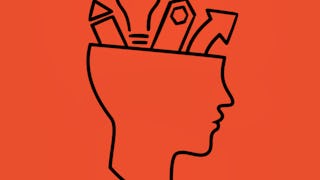In a world filled with pressing challenges, Design thinking offers a methodology that can transform lives and benefit people at large. At the heart of such design thinking is empathy and concern, a powerful enabler that helps bring ideas to life. This course explains the ‘7 CONCERNS OF INNOVATION’ that is involved in the design thinking process for a new product. Emphasising the iterative nature of innovation, this course also underscores the importance of navigating potential pitfalls at critical stages to prevent failure. Through engaging case studies, witness how these concerns shape the innovation process, driving it towards impactful solutions. The "7 CONCERNS" are as follows:

Cultivate your career with expert-led programs, job-ready certificates, and 10,000 ways to grow. All for $25/month, billed annually. Save now


Recommended experience
Details to know

Add to your LinkedIn profile
April 2025
8 assignments
See how employees at top companies are mastering in-demand skills


Earn a career certificate
Add this credential to your LinkedIn profile, resume, or CV
Share it on social media and in your performance review

There are 8 modules in this course
Introducing the fundamental concepts of design thinking and the 7 Concerns for Innovation. This module will establish the foundation for understanding how design can solve complex problems by focusing on user needs and iterative innovation. Understand the principles of design thinking. Familiarize yourself with the 7 Concerns for Innovation. Recognize the importance of collaboration in the innovation process.
What's included
4 videos1 reading1 assignment
Every design project is initiated by a ‘need’, which becomes ‘The Cause’ of the entire journey that follows. This need may be a commercial requirement, a social necessity or a specific niggling problem with an existing product. The recognition of such a need is a key trigger for the project and it can be identified by any of the stakeholders connected to the product – a product manufacturer or marketer, a user or a product designer.
What's included
8 videos1 reading1 assignment
To study and understand an existing product or similar products in the market, it is critical that the environment in which the product is used, which designers like to call 'The Context' is understood comprehensively. This means that a designer must study the users and their perspectives on the product. Often, this involves several rounds of interaction and observation.
What's included
7 videos1 reading1 assignment
At this stage, the designer analyses all the information gathered and methodically lists out their observations and perceptions of any notable issues in the use of the product. Such analysis results in the thorough, all-round 'Comprehension' of the product as it functions within the context of its use. The design insights thus arrived at give rise to creative ideas, and form the basis of the intervention that follows.
What's included
6 videos1 reading1 assignment
‘The Check’ is an essential step in understanding what requirements the product should ultimately meet and what problems the design intervention should address. The check, which is often a document in the form of a product brief, is created from the design insights and must be approved by the client. The product brief is an important point of reference throughout the journey as concepts and prototypes are created and evaluated.
What's included
6 videos1 reading1 assignment
At this stage called 'The Conception' , designer arrives at multiple ideas to come up with solutions for the problems listed using the product brief. At this crucial stage, ideas are proposed and grouped into clusters. This makes possible the consideration of multiple concepts. Finally, the team zeros in on one all-encompassing concept that best addresses all aspects of the product.
What's included
9 videos1 reading1 assignment
The final concept is further refined with reference to criteria like materials available or desirable, and the conditions in which the product is to be manufactured. At this penultimate stage, the designer creates several style options according to the user profile and selects one that best addresses all the aesthetic concerns. The chosen product design is showcased by 'Crafting' small-scale mock-up models, CAD models, or working prototypes. A final version of the product that meets all conditions in the product brief is then taken up for mass production.
What's included
7 videos1 reading1 assignment
The last but critically important concern is 'The Connection' the new product makes with the user. This connection or the bond between the user and the product is formed only when the user is satisfied with the product’s performance and begins to cherish it, which in turn creates an increasing demand for the product. In fact, it is the customer’s satisfaction that makes a winning project and functions as the most important criterion for innovation.
What's included
5 videos1 reading1 assignment
Instructor

Offered by
Recommended if you're interested in Entrepreneurship

The University of Sydney

Coursera Instructor Network

University of Virginia

University of Virginia
Why people choose Coursera for their career




New to Entrepreneurship? Start here.

Open new doors with Coursera Plus
Unlimited access to 10,000+ world-class courses, hands-on projects, and job-ready certificate programs - all included in your subscription
Advance your career with an online degree
Earn a degree from world-class universities - 100% online
Join over 3,400 global companies that choose Coursera for Business
Upskill your employees to excel in the digital economy
Frequently asked questions
Access to lectures and assignments depends on your type of enrollment. If you take a course in audit mode, you will be able to see most course materials for free. To access graded assignments and to earn a Certificate, you will need to purchase the Certificate experience, during or after your audit. If you don't see the audit option:
The course may not offer an audit option. You can try a Free Trial instead, or apply for Financial Aid.
The course may offer 'Full Course, No Certificate' instead. This option lets you see all course materials, submit required assessments, and get a final grade. This also means that you will not be able to purchase a Certificate experience.
When you purchase a Certificate you get access to all course materials, including graded assignments. Upon completing the course, your electronic Certificate will be added to your Accomplishments page - from there, you can print your Certificate or add it to your LinkedIn profile. If you only want to read and view the course content, you can audit the course for free.
You will be eligible for a full refund until two weeks after your payment date, or (for courses that have just launched) until two weeks after the first session of the course begins, whichever is later. You cannot receive a refund once you’ve earned a Course Certificate, even if you complete the course within the two-week refund period. See our full refund policy.
More questions
Financial aid available,


